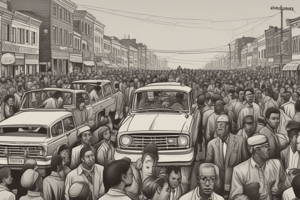Podcast
Questions and Answers
What did SNCC stand for?
What did SNCC stand for?
Student Nonviolent Coordinating Committee
Who founded the SNCC?
Who founded the SNCC?
Students two months after 1960 sit-ins at Woolworth's lunch counter in Greensboro, N.C.
Who was the first president during the SNCC?
Who was the first president during the SNCC?
John Lewis
What were sit-ins?
What were sit-ins?
What 3 sites had major SNCC events?
What 3 sites had major SNCC events?
During the Albany movement, what did Albany, Georgia become?
During the Albany movement, what did Albany, Georgia become?
What two programs were involved in the Albany movement?
What two programs were involved in the Albany movement?
What was the focus of the Albany movement?
What was the focus of the Albany movement?
Who led the Albany movement?
Who led the Albany movement?
Where did the SNCC March of African American high school students take place?
Where did the SNCC March of African American high school students take place?
What happened to them during the march?
What happened to them during the march?
Why did the Biracial committee form?
Why did the Biracial committee form?
During the Civil Rights Act, who became president and what did he push for?
During the Civil Rights Act, who became president and what did he push for?
What did the Civil Rights Act of 1964 accomplish?
What did the Civil Rights Act of 1964 accomplish?
Flashcards are hidden until you start studying
Study Notes
Student Nonviolent Coordinating Committee (SNCC)
- SNCC stands for Student Nonviolent Coordinating Committee.
- Founded by students inspired by the 1960 sit-ins at Woolworth's lunch counter in Greensboro, North Carolina.
- John Lewis, the first president of SNCC, became a congressman from Atlanta.
Sit-ins
- Sit-ins involve entering a public building and refusing to leave until served or demands are met.
Major Events and Locations
- Key SNCC events took place in Albany and Atlanta, Georgia.
- Albany became a central hub for civil rights activities, with a 40% African-American population yet limited voter registration.
Albany Movement
- Involved both NAACP and SNCC, focusing on integrating interstate bus station waiting areas.
- Activists faced immediate arrests during their efforts in Albany.
Leadership and Support
- The Albany movement was led by Dr. William Anderson, bolstered by support from black-and-white freedom riders.
March of African American Students
- SNCC organized marches of African American high school students to bus stations, resulting in mass arrests under national media scrutiny.
Formation of Biracial Committee
- A biracial committee was established to address the concerns of the African American community in Georgia.
Civil Rights Act Context
- Lyndon Johnson became president and advocated for the passage of the Civil Rights Act of 1964.
- The Civil Rights Act mandated integration of all public facilities, banned discrimination in businesses and labor unions, and penalized schools maintaining segregation by withholding federal funds.
Studying That Suits You
Use AI to generate personalized quizzes and flashcards to suit your learning preferences.




